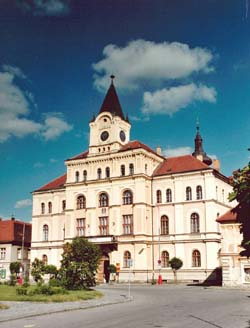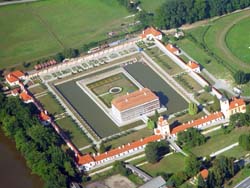Netolice Region |
|---|
TOWN HISTORY The Netolice town is situated in an articulated hilly countryside surrounded with ponds at the foothills of the Šumava mountains 427 m above sea level, halfway from České Budějovice, the capital city of South Bohemia, to Prachatice. The site was settled in ancient times already, which is evidenced with a number of tumuli and burial places from the Bronze Age in the surroundings. The Slavs probably settled in the Netolice region as early as in 8th century. The Netolici tribe is mentioned as one of the first tribes in Bohemia. The earliest written mention of the region in the Kosmas´ Chronicle dating from 981 mentions, in the context of a description of the Slavníkovci family estate, that the estate was situated north of the Austrian border castles of Chýnov, Důdleby, Netolice". After assassination of the Slavníkovci family in 995 the Netolice castle came into possession of the reigning family of Přemyslovci. Thanks to its strategic position at the crossing of important trading paths from the South and from Passau to the centre of the Bohemian valley the Netolice fortified castle on St. Ján hill became an important trading and administrative centre of the region and the seat of the princely governor. The first mention of the centre dates from 1167. The original market place and settlement was established below the castle around the St. Venceslas´ Church. Archaeologists have recently found here remains of town walls. After foundation of Zlatá Koruna by King Přemysl Otakar II in 13th century Netolice became property of this Cistercian monastery. South of the original market place with St. Venceslas ´s Church a new town was founded with a large, nearly a hectare square and the Assumption Church. After the death of Přemysl Otakar II in the Moravian Battlefield the Vítkovci family destroyed the monastery and plundered Netolice and the surrounding landscape. The town council was then headed by the magistrate, first mentioned in written materials of 1317. The earliest documented use of the town coat of arms for seal dates from 1326. Some Netolice citizens took part in the Hussite wars on the Hussite side. Especially in the context of the Jan Žižka´s military campaign against the Zlatá Koruna monastery and against Prachatice in 1420 the participation of Netolice citizens was driven by the intention to get rid of competitors in the area of the profitable salt trade. A year later the Hussites destroyed the guardian castle of the Rožmberk family called Poděhus and situated near Netolice. In 1468 King Jiří Poděbradský granted the town annual market right for St. Venceslas´ holiday. The town together held four annual market rights. In the same year the town was conquered and occupied by the famous warrior, Knight Jindřich Roubík z Hlavatec, who built his base there. In early 16th century the town became property of the Rožmberk family. In the latter half of 16th century a substantial change took place in the surroundings of Netolice. Not far from the town there was the Leptáč court, owned by the notorious pond builder and Rožmberk administrator, Jakub Krčín z Jelčan. King Vilém z Rožmberka exchanged the fortified settlement with him for Sedlčany, having a Renaissance hunting castle built here over the marshes called Kratochvíle, with a large deer park around. In 1599 the last member of the Rožmberk family, Petr Vok, dwelled in the estate with his cohort for a long period of time. In the middle of the greatest flourish the town was crudely hit with the Thirty Years´ War in 1619 being conquered and burnt by the Imperial Army of General Dampierre. Out of the total number of 143 houses 107 were burnt, including the Virgin Mary ´s Church, and the inhabitants were killed. The town took a long time to slowly recover from the blow. After the Rožmberk family the estate was held since 1622 by the Egenberk family, and taken over in 1799 by the Schwarzenberg family. The unique picture of the town dating from 1686 as well as in the painting a hundred years younger shows the town square and houses with timber archways. The original timber burgher houses still had a lot in common with the period country architecture. The modern progress of the town started in 18th and 19th centuries, when new schools, the town hall, the railway and (in 19th century) the regional council seat and the court of justice building were built. The Netolice marketplace played a significant part in the economic life of the region since the Middle Ages. Thanks to the position by a crossing of trading paths at the boundary of the Šumava and the Zbudovská blata mountains, forming part of the Českobudějovická basin, the town became a major trading centre. Markets were held there every week, mainly trading horses and cattle. For example as lately as before World War II the marketplace held up to 3,000 pieces of cattle. Thanks to that nearly thirty market inns prospered there. In 1945 the town was liberated by 26th infantry division of the US Army. The agreement on the demarcation line between the American and the Red Army was signed in Netolice. In the post-war period agriculture and industry developed in Netolice together with the continued tradition of pond building, horse breeding and baking. This and other details can be found in the web site of Netolice on: www.netolice.cz |
|||
TOWN SURROUNDINGS One of the major sights in the surroundings of Netolice is the Renaissance chateau called Kratochvíle with its beautiful chateau garden only 1.5 km away.
|
|||
HOTEL RYCHTA
Staré město 131
384 11 Netolice
tel: +420 388 324 603
tel: +420 602 160 463
e-mail: rychta@cbox.cz
| QR Code
|
| © HOTEL RYCHTA & BAZA GRAPHIC |



